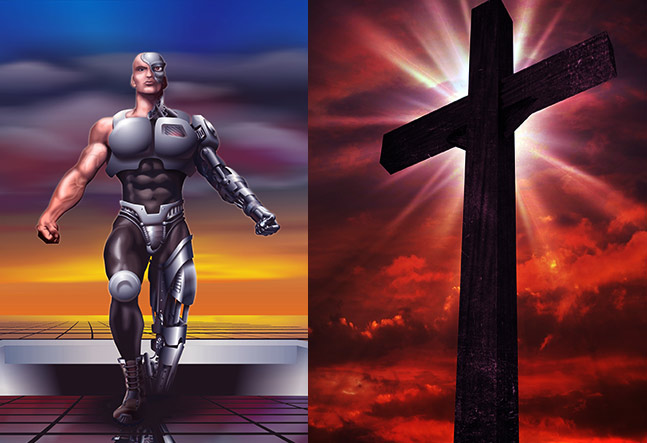THE SUPERHERO PARADIGM
Superheroes come in all sizes and shapes. Through the multiplication of superhero movies, they have become a kind of primary lens through which we look at ourselves: our hopes, our issues, our problems, our failures, our longings. Every sort of social and moral issue can be represented and examined in the superhero drama, even if they normally portray these superficially. They display for us the “adventure” that we all seek and enable us to taste the adventure that eludes us in our ordinary lives.
Occasionally, the superhero story is really just about the battle between a given superhero and his nemesis – a kind of personal battle between two powerful foes, with the populace looking on. But far more often, the superhero story expresses this common paradigm: an evil villain arises who endangers the wider populace (and usually the whole human race), and normal law enforcement has no chance against the superpowers of the villain. And so the superhero appears on the scene, often reluctantly, to do battle with the villain and overcome him (or her). e bulk of the story is all about how the superhero overcomes the enemy against all odds. And when the superhero has triumphed, however tragically, equilibrium and peace is restored to the world – and the superhero goes off into seclusion or attempts to carry on “normal life” until a new foe arises. This is the basic plot line – and it works. We are hooked by the hopelessness of the problem, foolishly worried whether the superhero will really be able to overcome evil this time, and greatly relieved when the deed is done. We seem to never tire of having this plot told and retold in endless variety.
The crucial thing to notice is that the end-game of the superhero paradigm is basic peace and order. The goal of the superhero plot is to return things to their normal and orderly state. Okay – sometimes we witness general improvement of values and opinions as a result of the struggle. But the typical goal is “restoration” of the previous order of ordinary people. Once the task of defeating the evil villain is accomplished, the superhero retires and things go on as they were. We could say that the “end” or telos of the superhero narrative is the peace of human society functioning freely and without oppression. Not a bad goal! But far from a Christian view of redemption of the world.
Let’s consider an example of this paradigm. In the acclaimed movie, Batman Begins (2005), the audience is introduced to Bruce Wayne both as a boy and as a young man who is striving to overcome the fear and guilt that weigh upon him due to the murder of his parents. He is a troubled boy—and a troubled young man – trying to find himself and overcome his fear. The human drama surrounding young Bruce Wayne is impressive. We as the audience are deeply sympathetic with his plight, cheering for him to fight through and face his fears.
The backdrop for the narrative is the city of Gotham, falling ever deeper into corruption, crime, and destitution. rough the efforts of Bruce Wayne’s parents, Gotham had been doing well. But now that they are off the scene, the city has crumbled and is pitching headlong into unrecoverable corruption. Gotham City and its people are the problem that needs a solution. Who will save the city? Rachel Dawes, Bruce’s boyhood companion, is an earnest, energetic district attorney, fighting (helplessly) against the wall of corruption. She also serves as Bruce’s conscience, calling him to leave behind his fear and anger and act on behalf of the city. But it is obvious that Rachel cannot save Gotham City on her own.
Bruce Wayne then goes underground, seeking some kind of salvation by mixing and mingling among the criminal classes. Eventually, he ends up in an unnamed Asian country where he is approached and recruited by Ra’s al Ghul, who trains him in the highest form of the martial arts. This is one part of the “superpowers” that Wayne attains. He becomes a great fighter, a living weapon, who can overcome nearly any human foe. For his part, Ra’s al Ghul also has a plan for Gotham City: he believes that it must be utterly destroyed and built new from the ground – and he hopes to win Bruce Wayne to his cause. Wayne refuses—he leaves amidst a bloody battle and returns to Gotham City to undertake his own way of “saving” the city from corruption. ere he runs across a specialist in his company who introduces him to the most developed military weapons and gadgets ever produced. This is the other half of Batman’s superpowers: he has an arsenal, a motorized vehicle (the Batmobile), and high-tech equipment that enable him to do far more than a normal human being could accomplish.
What then unfolds is a complex plot in which Ra’s al Ghul returns (with his cronies) to bring about the destruction of the city, even as Wayne (now Batman) is fighting to rid the city of its entrenched criminals and corrupt officials. e inevitable showdown between Batman and his former trainer provides the climax of the lm. And unsurprisingly, Batman wins the contest and saves the city from destruction. But things are never that simple when sequels must be produced. So we find that a hoard of criminally insane characters was released from a mental hospital, setting the stage for the arrival of the Joker and the plot for the next film.
Batman Begins is a highly effective example of the superhero paradigm. The city of Gotham is threatened, millions of lives are at stake, and a solution must be found. Two opposing answers clash – and the audience is meant to identify with the solution proposed by Batman, however imperfect and slow in execution. Through a series of encounters in which Batman must use all his prowess, his gadgets, and his wits and courage, our superhero defeats the powerful villain and (for a short time) the city is saved. e people can go on with their normal lives, free of the threat of imminent destruction.
The enormous popularity of superhero comics and movies demonstrates that we are drawn to them like magnets. Our culture gladly embraces endless refractions of this basic story. And crucial to the attraction of the superhero is the combination of superpowers with real human qualities. We can identify with these superheroes because they are human like we are: they make mistakes, they have fears, and they wrestle with personal problems and relationship issues. Despite their superpowers they are vulnerable – as we are – in one way or another. Even Superman, possessing perhaps the greatest of all powers, falls sick and in danger of death in the presence of kryptonite. At the same time, we are drawn to and mesmerized by their powers and abilities, physical and intellectual. They seem to draw us upwards and lift us into a world that, all too briefly, transcends our normal, mundane lives.
JESUS IS NOT A SUPERHERO
As it turns out, many people basically adopt something like this superhero view of Jesus and what he came to do. Surveying the religious beliefs of teenagers, Christian Smith summarized their basic theistic worldview as “moral therapeutic deism.” What he means by this is that most young people believe God wants us to be good (“moral”), and that God is mainly there to help me with my personal needs (“therapeutic”), but that otherwise God just leaves us to get on with our lives (“deism”). Most people believe in God – he is good and watches over things. But he doesn’t need to be particularly involved in our life unless things go really wrong. When we have a problem, that’s when we call upon God and he comes to help – and then he goes off again to a safe and convenient distance, leaving us to go on with life on our own terms. This is really a superhero view of God.
Is the superhero paradigm a good model for the redemption that Jesus came to bring? Is he just the greatest of the superheroes? Not really. While there are some similarities, Jesus is not a superhero. From the perspective of Christian faith, the human race has a massive problem that needs solving. e Apostle Paul sums up the main elements of our problem very concisely:
You were dead through the trespasses and sins in which you once lived, following the course of this world, following the ruler of the power of the air, the spirit that is now at work among those who are disobedient. All of us once lived among them in the passions of our flesh, following the desires of flesh and senses, and we were by nature children of wrath, like everyone else.
Ephesians 2:1-3, NRSVCE
This is our predicament: we are slaves of sin and can’t escape by our own efforts. We stand under the sentence of death and can’t evade it. We live under the dominion of the devil, unable to overcome him by our own powers. It is from these that Jesus came to deliver us.
But notice: he didn’t just swoop down from the sky, defeat our enemies in a furious battle, and then retreat back to his own place. In order to redeem us, the eternal Son of God actually became one of us – not as a disguise or as a temporary identity, but so that he could renovate our nature from within. He didn’t just come to defeat our enemies and leave us in peace; he came to change us inside and out, to bring about a new creation. And he himself – Jesus, the Son of God – is the beginning of that new creation.
In the superhero paradigm, once the enemy has been defeated, we go back to our normal lives, free from oppression (for the time being). That’s far better than living under the oppression of a tyrant. But Christ came to bring us so much more. Salvation in Christ means being joined to him and becoming part of his body. He doesn’t just restore things to a peaceable order; he brings about a new creation. Jesus didn’t come on a special ops mission – a sting operation – and then withdraw to leave us in peace. He is our peace! We have life by being joined to him, and through the Spirit we are made into his image and likeness.
Have you ever heard the slogan that says, “Christians aren’t perfect, just forgiven”? Well, we certainly aren’t perfect – not yet. But we are far more than just forgiven. If we are “just forgiven,” just reinstated to where we were before, then we remain unchanged and all our enemies can still gain power over us again. God our Father has much more in store for us, his sons and daughters, than just forgiveness. We profoundly need to be forgiven, but we are also called and empowered to be transformed (Rom 8:29), to become new beings (2 Corinthians 5:17), to be perfect and complete like our heavenly Father is perfect (Matthew 5:48). None of this happens in the superhero version of Christian faith. For this to happen we need a living Christ, active in our lives. We need to have our lives be “in Christ,” his life becoming ours: “I am the vine, you are the branches. e one who abides in me, and I in him, bears much fruit, for apart from me you can do nothing” (John 15:5).
It is a curious fact that superheroes don’t need to love the people they protect and save. They don’t even need to like them very much, and they certainly don’t have to live among them. Commonly, superheroes “enter the fray” and confront evil somewhat reluctantly. They do so because they see a desperate need or because they feel an obligation to help because of their superpowers. Only rarely do they show genuine love for the people they are serving, and when this happens it is often because they become romantically entangled with non-superheroes. e contrast with our heavenly Father and the Son he sent couldn’t be sharper: “For God so loved the world, that he gave his only Son, that whoever believes in him should not perish but have eternal life” (John 3:16, ESV). Paul reminds us that Christ loved us even when we were his enemies, when we rejected him entirely: “Why, one will hardly die for a righteous man – though perhaps for a good man one will dare even to die. But God shows his love for us in that while we were yet sinners Christ died for us” (Rom 5:7–8, RSVCE). God sent his Son out of love for us, even when we did not merit this love. And after saving us, he does not withdraw and leave us to ourselves, but draws us to himself. e good news of the Gospel is that God himself is the source of our life: “I came that they may have life, and have it abundantly” (John 10:10, ESV). God himself has given us eternal life through the gift of his Son (1 John 5:11).
THE GLORIOUS TRUTH OF THE INCARNATION
The Son of God took on the poverty of our human condition in order to raise us to the riches of his divine life (2 Corinthians 8:9). And yet he didn’t just appear in human form as a kind of disguise to do a job. e humanity of Jesus is not just a set of clothes that he put on and then took off. He isn’t like the aliens in the movie Men in Black who possess human bodies. Our faith tells us that Christ really became a man – a genuine human being – in order to renovate and renew our humanity from within.
RoboCop is “part man, part machine.” But Christ is not “part man, part God.” He is fully man, fully God, and entirely our Redeemer. In fact, Christians in the early Church flirted with this composite model of the Incarnation, that the Jesus of the Gospels is part man and part God. But this was rightly seen as inadequate. He is not a midway point between man and God, half of each but not fully either one. No, he remains fully God while becoming fully a human being – he joins the two by being fully both.
To say this differently: Jesus was sent by the Father to show us who we truly are. He didn’t just win a victory; he revealed what it is to be a human being. He didn’t just provide us with a model to follow (though he certainly did do that); he came to make us new. We can imitate him and follow his model only by being joined to him and by freely cooperating with his grace and power in our own transformation. And crucially, when he rose from the dead he didn’t leave our nature behind, but died and rose again in our nature. Jesus did not “wear” our human nature for a season and then cast it off. Even now, we believe, he lives in a glorified human nature – and this is what we are called to share in.
Superheroes, and, in fact, many science-fiction characters, contain within them elements of truth and reflect in a partial way the longing in our hearts to be something more – to find fulfillment in something beyond what we now experience. But even as they point to what we long for, they fall short of that goal. Only in the person of Jesus do we find the true fulfillment of our longings. Only in the Incarnation of the Son of God and the new life he brings can we achieve the transformation that God, the author of the story, has in store for us. Jesus doesn’t just return us to a state of peace and normality and leave us as we were; he triumphs over sin and death in us, makes us each into a “new creation” (2 Corinthians 5:17), and brings into being a new community called the Church that will live with him and in him for all eternity. This is what God has in store for us in his Son.
This article is excerpted from The Adventure of Discipleship, Chapter 4, ©2018 by Daniel A. Keating, published by Emmaus Road Publishing, Steubenville, Ohio, USA. Used with permission.
Top composition of two illustration of a superhero warrior and a shining symbol of Christ’s victory on the cross, both illustrations from Bigstock.com, © by patsm, stock photo ID: 10789511, and by © Virrage Images , stock photo ID: 50160386.
Dan Keating, (DPhil, Oxford University, UK) is an elder in The Servants of the Word, an ecumenical international brotherhood of men living single for the Lord. He is a professor of theology at Sacred Heart Major Seminary in Detroit, Michigan, USA where he teaches on Scripture, the Church Fathers, evangelization, and ecumenism.



